MARIANI’S
Virtual
Gourmet
January 27,
2019
NEWSLETTER
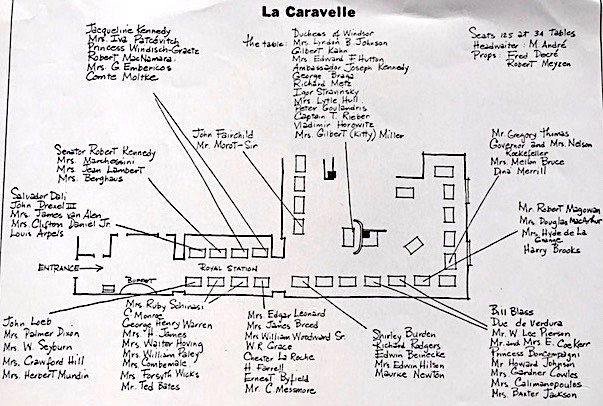
❖❖❖
IN THIS ISSUE
JADE MOUNTAIN ON ST. LUCIA
By John Mariani
NEW YORK CORNER
MAMO
By John Mariani
NOTES FROM THE WINE CELLAR
SUSANA BALBO WINES OF ARGENTINA
By John Mariani
❖❖❖
JADE MOUNTAIN
ON ST. LUCIA
By John Mariani
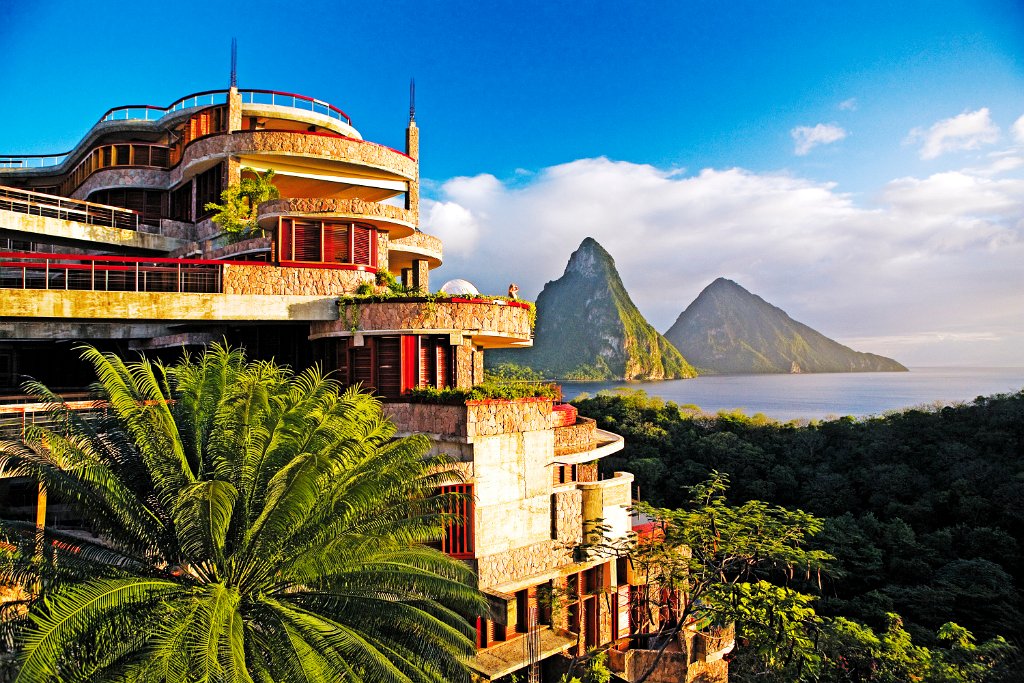
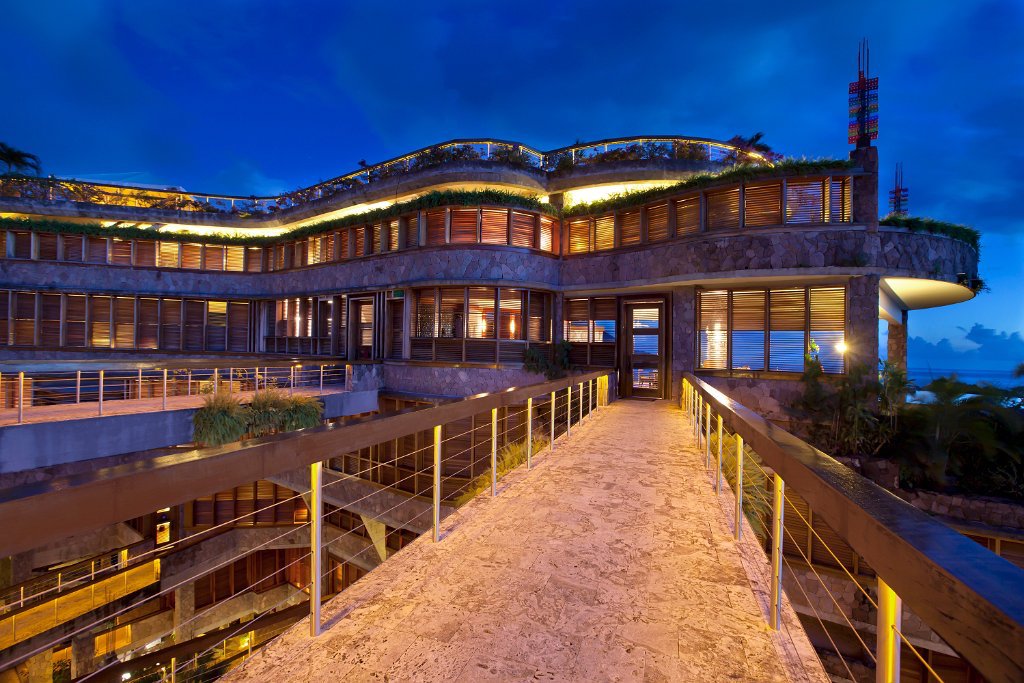 Set within proximate
sight of the island’s beautiful Piton Mountains—a
World Heritage Site—and reachable only by bumping
along a rocky road through deep, dark tropical
forests, Jade Mountain is the dream of
architect-owner Nick Troubetzkoy, who insists that
his resort must fit organically into the natural
world around it.
This translates as soaring columns of stone
and Gaudi-like tiled bridges leading to 24
secluded suites (some called “Sanctuaries”) in
four price categories, each with its own private
infinity pool made of recycled glass completely
open to the trade winds.
Set within proximate
sight of the island’s beautiful Piton Mountains—a
World Heritage Site—and reachable only by bumping
along a rocky road through deep, dark tropical
forests, Jade Mountain is the dream of
architect-owner Nick Troubetzkoy, who insists that
his resort must fit organically into the natural
world around it.
This translates as soaring columns of stone
and Gaudi-like tiled bridges leading to 24
secluded suites (some called “Sanctuaries”) in
four price categories, each with its own private
infinity pool made of recycled glass completely
open to the trade winds.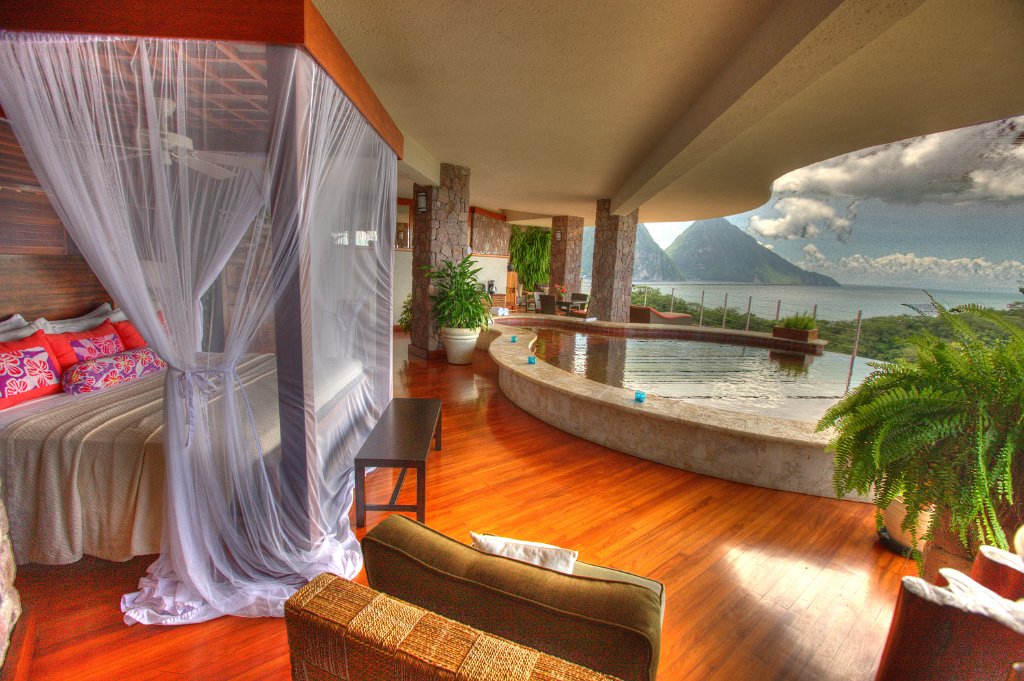
How local workmen fashioned this extravaganza, which included hauling 20 species of tropical hardwood up the hillsides, is bewildering, all of it to create rooms with 15-foot ceilings, massive poster beds draped in gauze (with no fourth wall in the room, mosquitoes can buzz on in), massive armoires and an open bathroom with every amenity.
Down below are two white sand beaches covering 600 acres and offering an array of water sports and activities, including a catamaran that takes you under the shadow of the Pitons, which are named Gros and Piti.
St. Lucia, in the Lesser Antilles, is independent, though for centuries it was ruled by the French and British—each seven times!—earning it the nickname "Helen of the West Indies.” In 1836 slavery was abolished, by which time the black population already far outweighed the Europeans.
Owing to its southern location, St. Lucia is below the Caribbean hurricane zone, and the trade winds keep average summer temperatures below 90 degrees, with the rainy season arriving in autumn.
There is some industry on the island and its agriculture sector is growing, but tourism still drives the economy, with the high season January to April, when people come to visit the drive-in volcano, the springs at Soufrière, the Botanical Gardens and even to climb the Pitons. Most hop on and off the island from huge cruise ships that dock at the capital city of Castries.
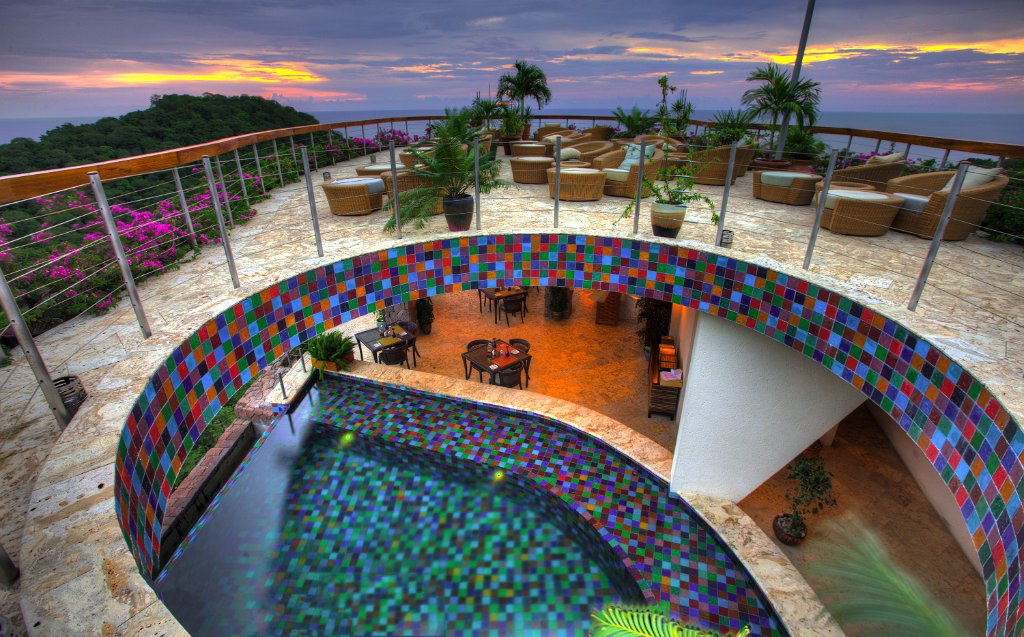 Troubetzkoy and his
wife, Karolin, began as visitors to St. Lucia and
eventually bought the Anse Chastenet resort
adjacent to Jade Mountain, which is a far more
personalized and truly eccentric property with a
secret logic behind it. I am not the first to report
that Jade Mountain is not for everyone. That very
rocky, jolting road is meant to keep non-guests
from getting to the beaches, and, once you’ve
entered the premises, you are unlikely to face
that rugged road trip for the length of your stay.
(Boats will take you to other parts of the
island.)
Troubetzkoy and his
wife, Karolin, began as visitors to St. Lucia and
eventually bought the Anse Chastenet resort
adjacent to Jade Mountain, which is a far more
personalized and truly eccentric property with a
secret logic behind it. I am not the first to report
that Jade Mountain is not for everyone. That very
rocky, jolting road is meant to keep non-guests
from getting to the beaches, and, once you’ve
entered the premises, you are unlikely to face
that rugged road trip for the length of your stay.
(Boats will take you to other parts of the
island.)
Also, the rugged and often unpaved roads and staircases on the property take a good deal of stamina to navigate, and the route to the beaches is a trek down hundreds of uneven steps. Fortunately, the resort has vans and SUVs to pick you up throughout the premises and get you back to your suite. You need only to dial up a personal butler on a phone you carry with you.
Then
there is the total absence of TV, video and movies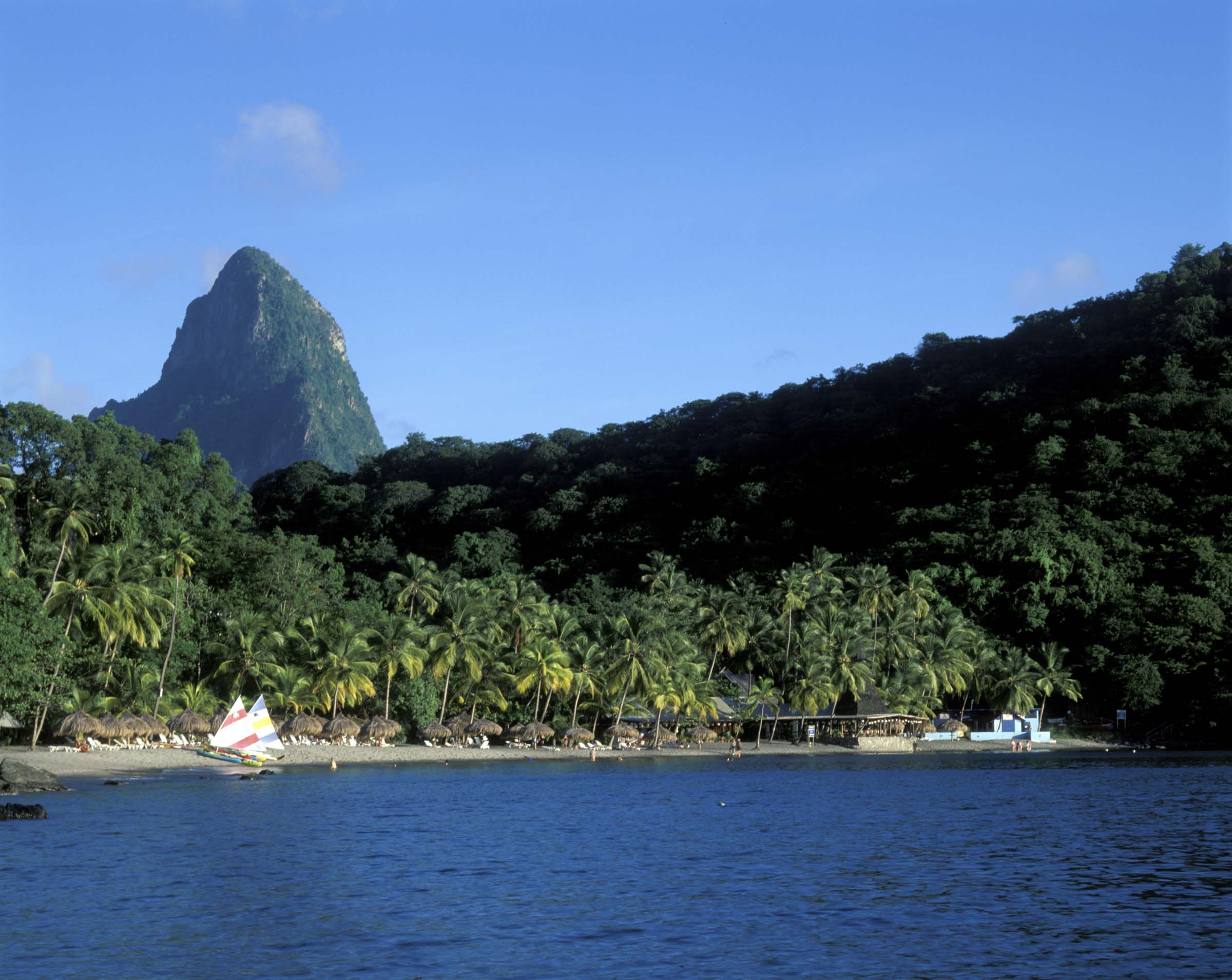 (iPhones, however, do work pretty
well). The intent is to allow guests to zone out
completely, but I’ve always felt that such people
simply need not turn on TVs or movie channels if
they don’t choose to. The rest of us might prefer
to zone out watching TV or movies. Most of us, I
would expect, also would prefer the option of
air-conditioning, which is installed in only one
room.
(iPhones, however, do work pretty
well). The intent is to allow guests to zone out
completely, but I’ve always felt that such people
simply need not turn on TVs or movie channels if
they don’t choose to. The rest of us might prefer
to zone out watching TV or movies. Most of us, I
would expect, also would prefer the option of
air-conditioning, which is installed in only one
room.
Not that the eager visitor will lack for things to do. There is a scuba center with full diving program, a Jungle Biking Center (not for the unadventurous), coastal kayaking, sunfish sailing, windsurfing, tennis, a Cybox Fitness Studio, and the opportunity to visit the property’s ever-growing tropical organic farm. One of the loveliest of activities is a cruise on the resort yacht Searenity [sic] or a “Jazzy Sunset Cruise” on a 60-foot catamaran (below). The sunsets can be dazzling and for the first time in my life I got to see the fascinating “green blast” that sometimes occurs at the last split second of the sun’s dropping below the horizon.
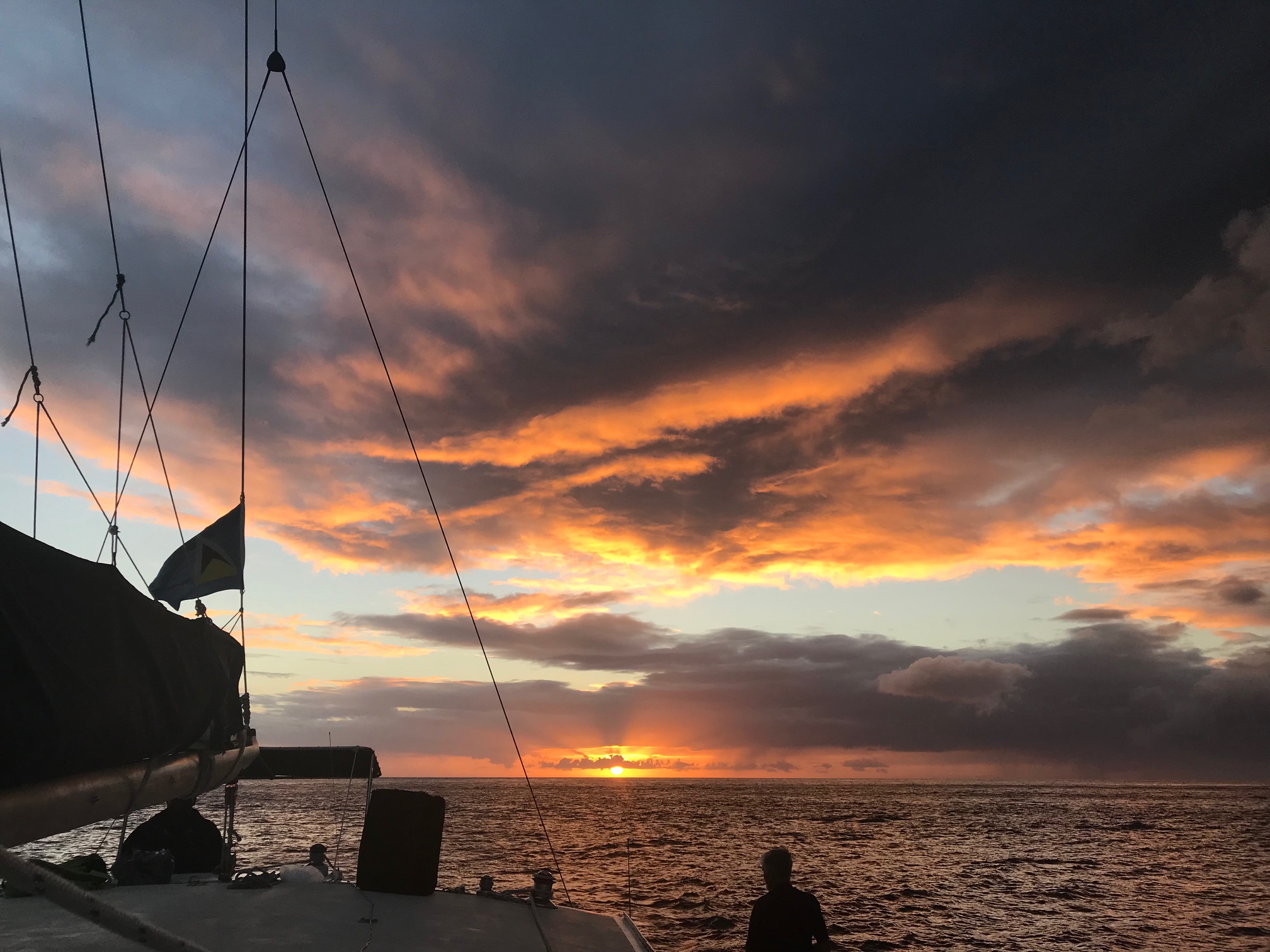 Good restaurants in the
Caribbean are rarities, largely because of the
unavailability of ingredients, including seafood.
So my wife and I were happy to find that Allen
Susser, whose sterling career I’ve followed and
applauded in Florida for more than twenty years,
is onboard as consulting chef, along with
Executive Chef Jonathan Deardon, who has worked
for years to grow as much provender as possible
and contract local farmers and fishermen to
guarantee the best that is available.
Good restaurants in the
Caribbean are rarities, largely because of the
unavailability of ingredients, including seafood.
So my wife and I were happy to find that Allen
Susser, whose sterling career I’ve followed and
applauded in Florida for more than twenty years,
is onboard as consulting chef, along with
Executive Chef Jonathan Deardon, who has worked
for years to grow as much provender as possible
and contract local farmers and fishermen to
guarantee the best that is available.
Susser also began the resort’s own Chocolate Lab, using the property’s cacao beans, which are roasted, fermented, ground and made into a variety of desserts and chocolate bars for sale at the resort. Each year they hold a Chocolate Festival, which includes tours, excursions and chocolate-centered dishes throughout.
The two best restaurants at the resort are the Jade Mountain Club (below), which is exclusively for the use of resort guests, and Apsara, down at the beach, serving delicious Indian/Caribe cuisine.
After
a long flight from New York and an hour’s ride to
the resort, my wife and I were ready to be
pampered. So, having cocktails on the terrace of
the Jade Mountain Club allowed us to slip into
Island Time that evening, followed by an excellent
dinner that included curry-and-cumin spiced
farm-raised prawns with shaved cucumber, green
banana salad and lemon sauce; a crispy chicken
roll with chorizo 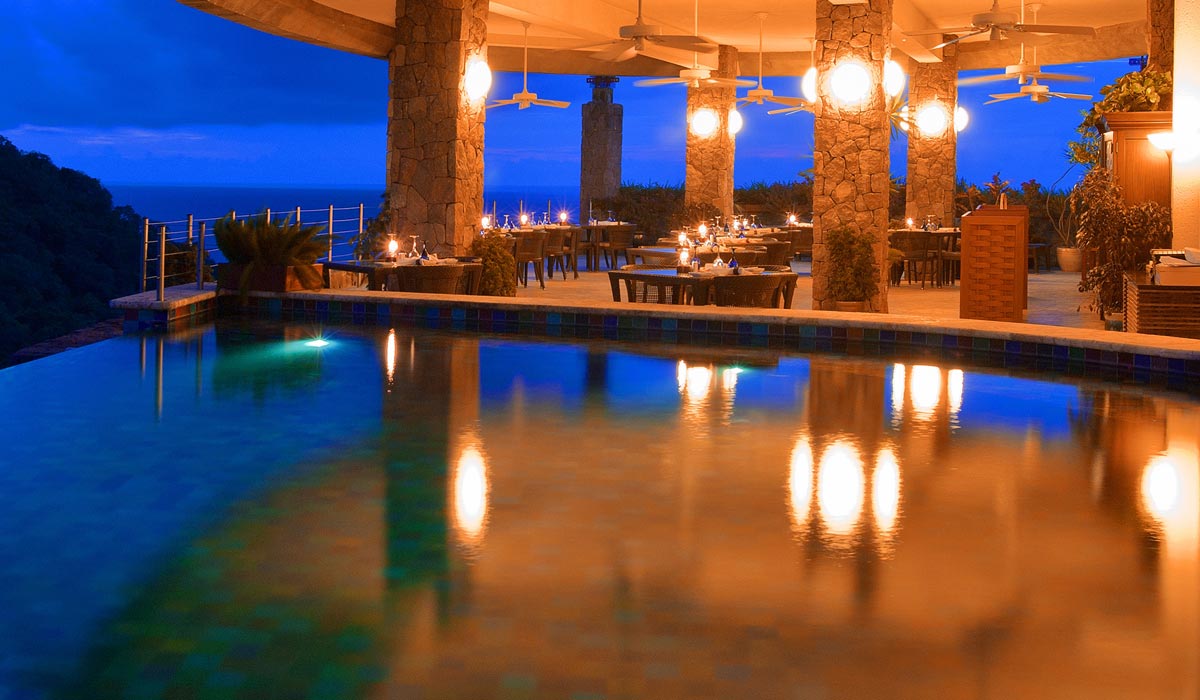 escabeche, local
potatoes and pineapple compote; perfectly cooked
spiced mahi mahi with coconut rice pilaf, baked
pumpkin and seafood bisque; and a superb seared
red snapper with leek risotto, sautéed Malabar
spinach and a saffron nage. For dessert there was
mango baked Alaska and a lemongrass and ginger
cheesecake with dark chocolate ganache, beetroot
bubbles and caramelized bananas. It was a blissful
evening.
escabeche, local
potatoes and pineapple compote; perfectly cooked
spiced mahi mahi with coconut rice pilaf, baked
pumpkin and seafood bisque; and a superb seared
red snapper with leek risotto, sautéed Malabar
spinach and a saffron nage. For dessert there was
mango baked Alaska and a lemongrass and ginger
cheesecake with dark chocolate ganache, beetroot
bubbles and caramelized bananas. It was a blissful
evening.
We also enjoyed a simple lunch on the beach at Anse Chastenet of grilled lobster, accompanied by cold Piton beer.
Breakfasts, full of fresh fruit, were very good, but, sorry to say, service on Caribbean Time meant interminable waits for the food to arrive.
On that first night at Jade Mountain, we looked up at the star-spangled sky and saw a vivid crescent moon lying on its bottom rim. Where I live crescent moons stand upright, but by its position in the equatorial sky it seemed as if it were cradling a star in its arms as the trade winds blew gently across the room.
Jade Mountain is an all-inclusive resort.
❖❖❖
By John Mariani
323 West Broadway (near Canal Street)
646-964-4641
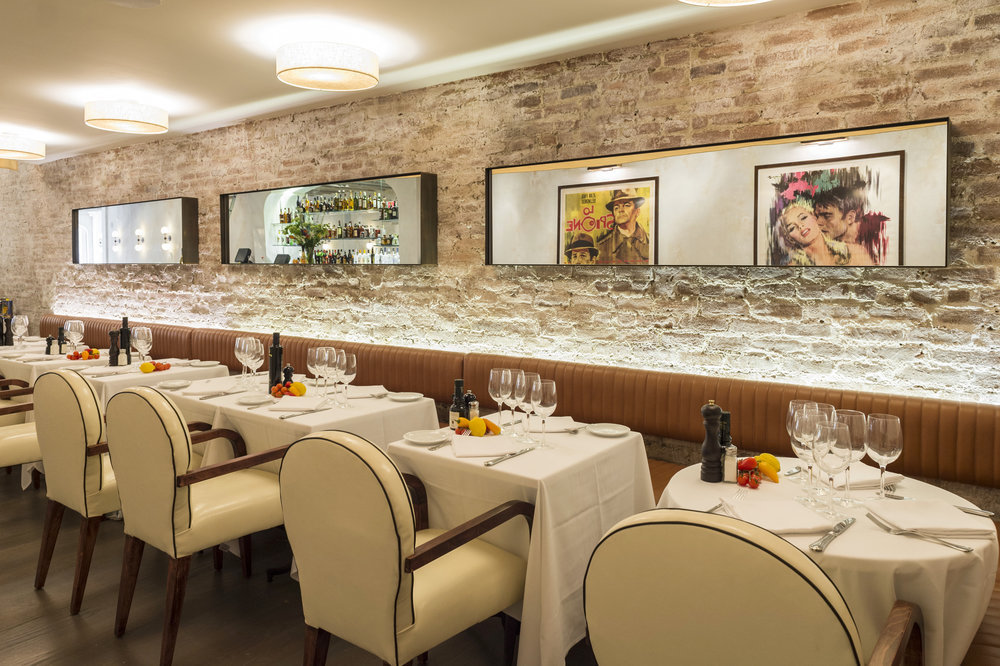
Buzz,
like the irresistible smell of a new car,
does not last forever, but a finely tuned,
good-looking car can be a joy to those who
appreciate the consistent delivery of what
it was they loved about it the day they
bought it.
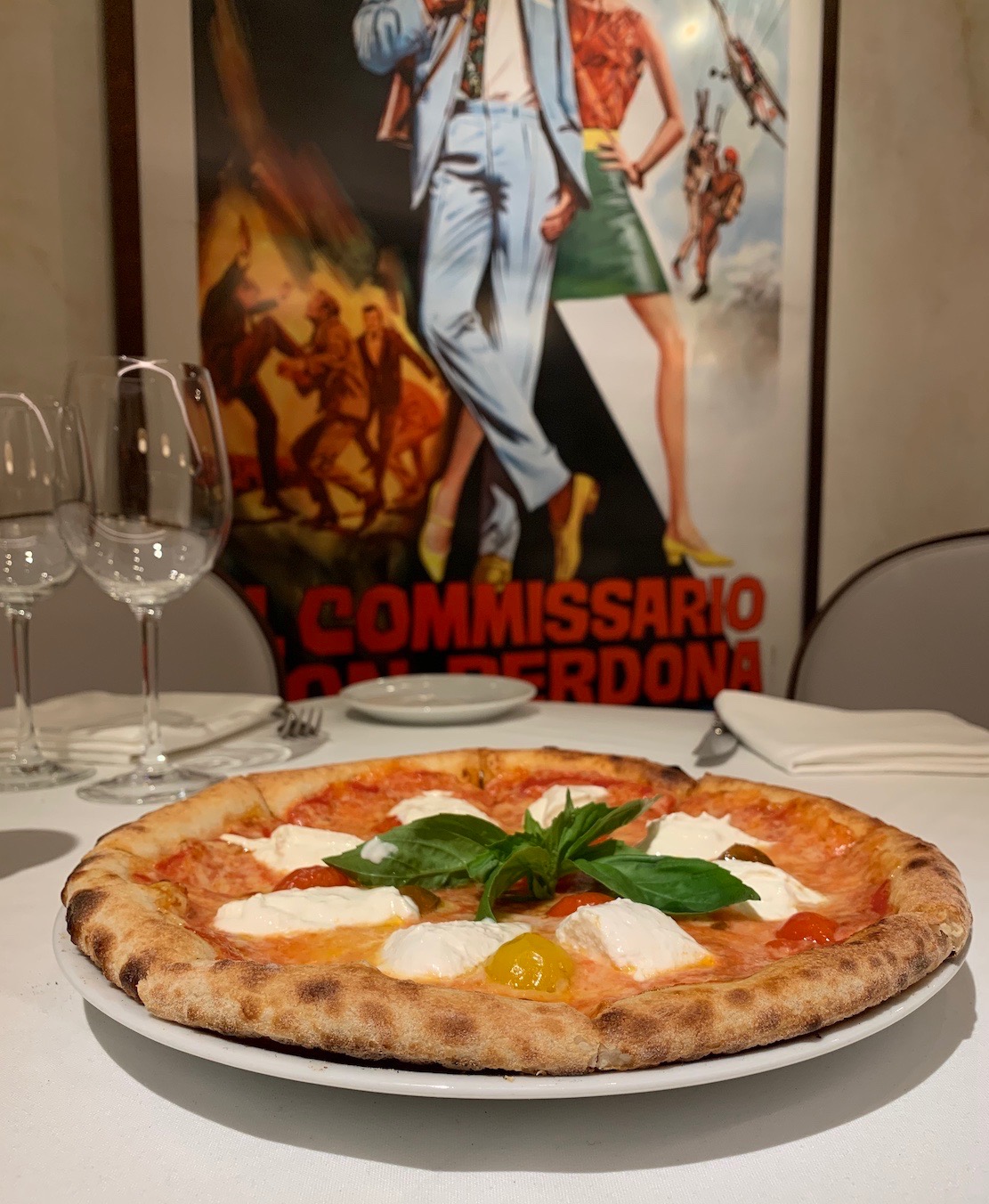 Mamo in
Soho seems to have achieved that same effect
on regulars, who once might have come for the
celebrity clientele when it opened three years
ago and for its association with the original
Mamo in Antibes on the French Riviera, but who
now come back for the loveliness of the décor
and the consistency of its food, via Chef Salvatore
Marcello, who has pretty much maintained the
opening menu.
Mamo in
Soho seems to have achieved that same effect
on regulars, who once might have come for the
celebrity clientele when it opened three years
ago and for its association with the original
Mamo in Antibes on the French Riviera, but who
now come back for the loveliness of the décor
and the consistency of its food, via Chef Salvatore
Marcello, who has pretty much maintained the
opening menu.
The lights seem a little
lower now, casting a soft glow against white
brick walls hung with brightly colored Italian
movie posters. The upholstered leather
chairs are among the most comfortable in New
York. The music also seems to have been turned
down a bit from its previous cacophony, though
I visited on a wintry weeknight.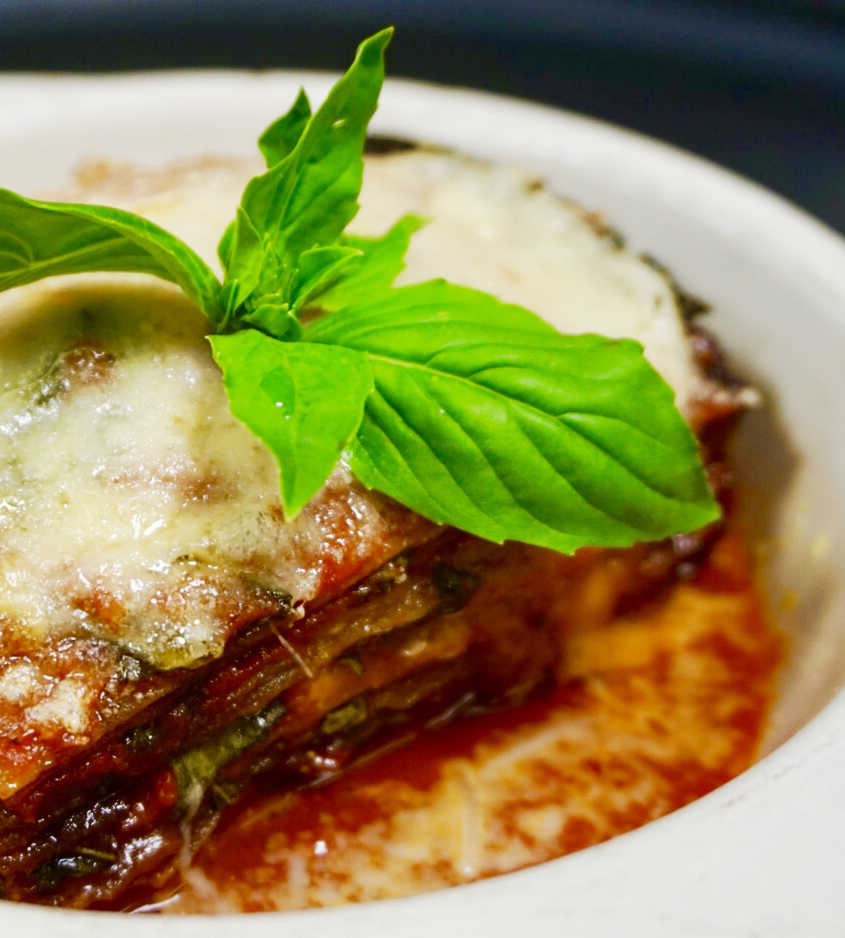
Sorry to report that the
prices on the wine list are insanely high for
no good reason, with few bottles under $100
and most running north of $150. Chȃteau
Gloria 2009 sells for $40 in a NYC wine shop;
at Mamo it’s a cough-inducing $200; Pio Cesare
Barolo 2013 is $50 retail, at Mamo $175.
Just
about every restaurant is selling pizza these
days and Mamo makes some very good ones,
especially the “Milana” ($22), with
Cantal cheese, burrata, tomato,
cherry tomatoes and basil, a good starter for
a table of four. Right now, as the white
truffle season draws to a close, there are
several dishes, including pizzas, that include
them, but be prepared for sky-high prices.
There are a number
of other good openers, including fried
artichokes with pepper and grated cheese ($18)
and warm eggplant parmigiana
($19). The full portions of pasta
are very hearty and may be split, not least rigatoni
all’amatriciana ($19)
and the gnocchi are perfect small dumplings
(too often they can be large and lumpish) with
a rich Gorgonzola sauce ($21). Maccheroni
al ferretto ($20) is made with fresh
Calabrian-style macaroni graced with butter,
sage, a little lemon and Parmigiano.
Main
courses are more sumptuous than elsewhere
around town, beginning with a
halibut baked in foil with a truffle fondue
($38) and the veal alla
Milanese ($46) is sided with salad and
cherry tomatoes, which, if placed on top,
would cause the meat’s crispy crust to become
soggy. There’s a fine 12-ounce New York strip
steak with sautéed potatoes and herbed olive
oil ($44), and by all means share the MAMO
meatball ($42), the size of a baseball,
riddled with truffles with a creamy
four-cheese polenta.
The Italian desserts are
fairly predictable, but no less appealing for
that. The panna cotta with apple crumble ($12)
and the vanilla torta ($12) are all fine, but
the chocolate mousse for two ($22) comes with
a large container of whipped cream that a
table of four may not finish.
I wouldn’t judge a
restaurant’s service on a post-holiday
mid-week evening, but slow and inattentive
would describe our experience that night.
Mamo’s
culinary appeal is too admirable for the
owners to keep on their website
celebrity sightings three years old of Magic
Johnson, Jay Z and Beyoncé at the restaurant.
If Mamo hasn’t seen such buzz in a while, it’s
because it has now settled down into being a
better restaurant.
Mamo is open for lunch Mon.-Fri., dinner nightly and brunch Sat. & Sun.
❖❖❖
OF ARGENTINA
By John Mariani
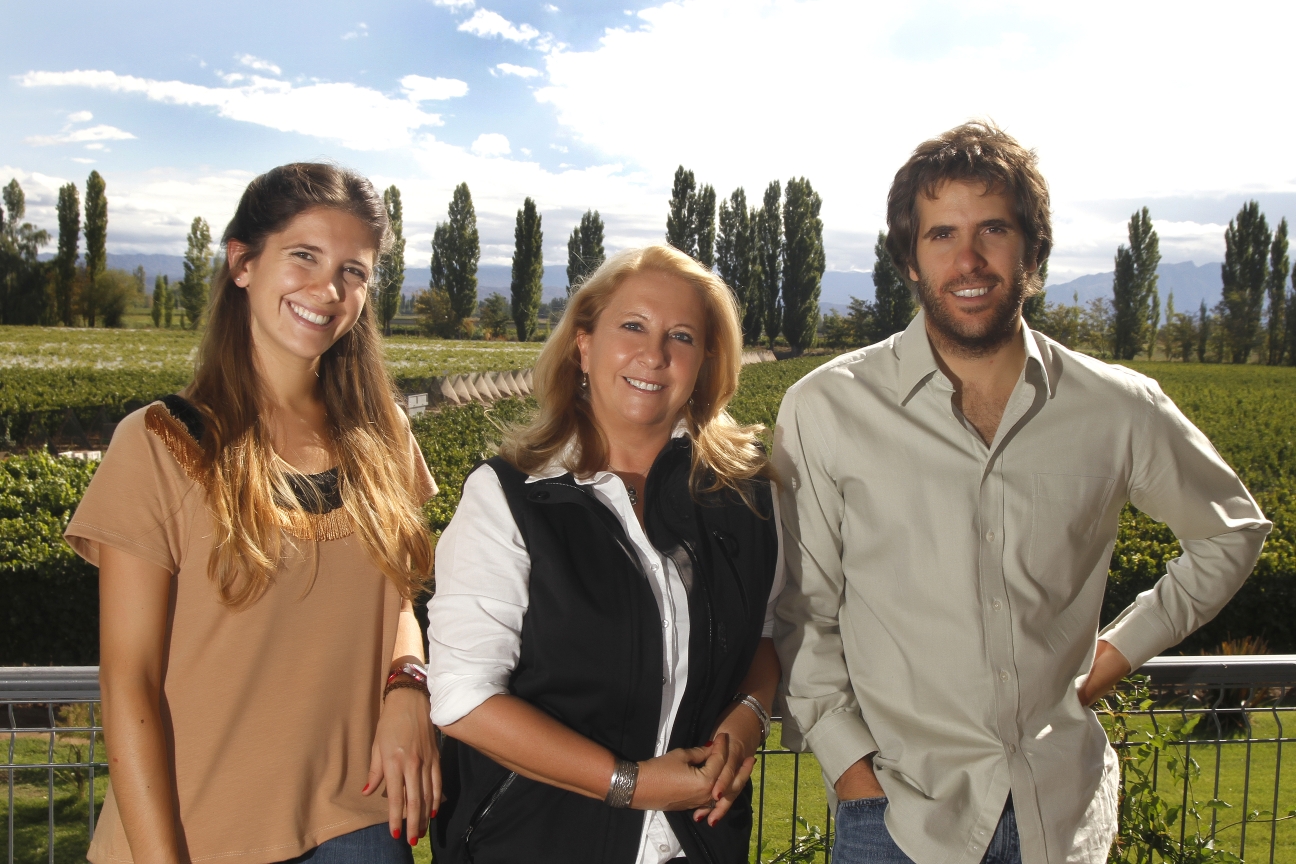
Few
winemakers of whatever sex have in so short
a period of time achieved the respect and
honors of Argentina’s Susana Balbo, whose
wines I have long counted among the best
coming out of the Mendoza territory.
Early on, Balbo sought to
pursue a career in nuclear physics, which her
parents thought a “very unconventional choice
for the time” and refused to let her leave
Mendoza. So she knuckled under and became
involved with the family’s viticultural
business and in 1981 became the first woman in
Argentina to receive a degree in enology. She
then devoted herself to researching the
Torrontes grape at the Michel Torino winery,
then worked at Martins and Catena Zapata and began
consulting at wineries in South America,
Europe and Australia. In 1999 she founded
Susana Balbo Wines in Luján de Cuyo, Mendoza,
and today her son, José, graduate of UC Davis,
and daughter, Ana, graduate of University San
Andrés (Buenos Aires), have joined her in the
family venture (above).
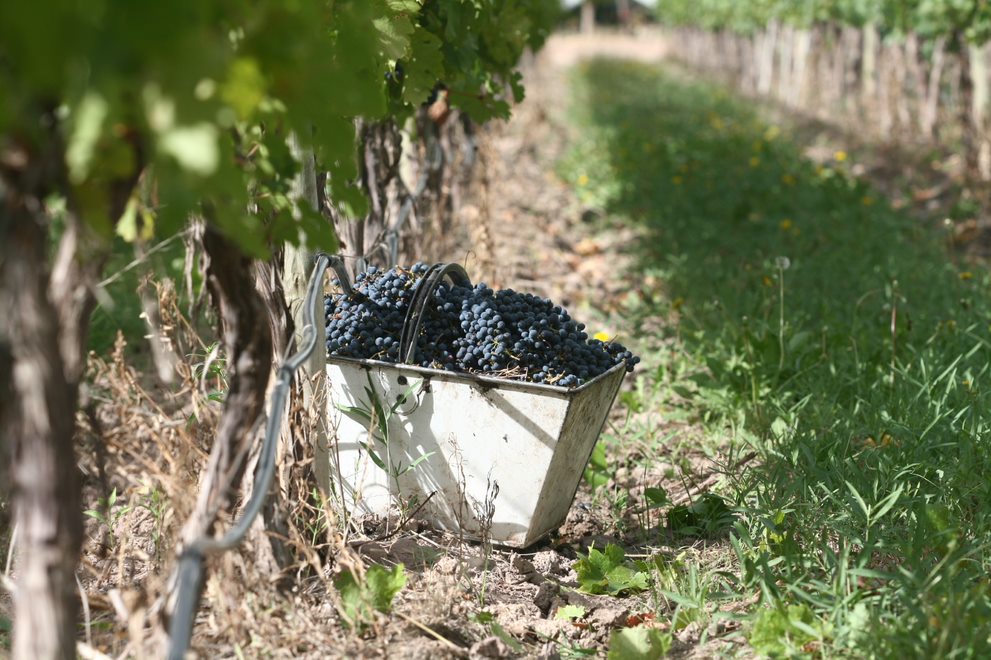 To date
she has won a wide array of awards. In 1997, she was elected Woman
Entrepreneur of the Year by the Argentine
Organization of Businesswomen; between 2006
and 2016, she served as president of Wines of
Argentina, and last year made The Drink Business
magazine’s
list of "The 10 most influential women in the
wine world.” Space alone prevents me from
listing so many more achievements.
To date
she has won a wide array of awards. In 1997, she was elected Woman
Entrepreneur of the Year by the Argentine
Organization of Businesswomen; between 2006
and 2016, she served as president of Wines of
Argentina, and last year made The Drink Business
magazine’s
list of "The 10 most influential women in the
wine world.” Space alone prevents me from
listing so many more achievements.
As you’d expect from a
woman with such energy and drive, she has
opened her
winery to agro-tourism, with two restaurantes
on the property, Osadia
de Crear and
Espacio Crios.
Of course, the
ultimate proof of quality is in the bottle,
and Balbo has said that “the
winery is like my third child, a dream come
true.” In that regard there are many siblings,
though not so many as to make me question
whether the winery is straining to please
everyone. I’ve tasted several that are now in
the market and here’s what I found.
Susana Balbo Rosé
of Malbec 2018 ($20)—Rosés
have made considerable headway in South
America, and this one, made from 60%  Malbec
and 40% Pinot Noir, has real finesse to it,
with just enough alcohol (13.2%) to bolster
its fruit flavors. It is cold macerated with
dry ice for one hour. An ideal apéritif that
can go with any seafood that comes afterwards.
Malbec
and 40% Pinot Noir, has real finesse to it,
with just enough alcohol (13.2%) to bolster
its fruit flavors. It is cold macerated with
dry ice for one hour. An ideal apéritif that
can go with any seafood that comes afterwards.
Susana Balbo Brioso
White 2017 ($24)—This is a white blend of 45%
Semillón, 30% Torrontes and 25% Sauvignon
Blanc, the last enriching the fruit component,
with the Semillón providing the lush aroma.
The grapes are pressed without maceration, and
after fermentation the wine spends a month on
the lees, spending 4 months in 60% first -use
French oak and 40% second-use. There’s a
light, pleasing grassy edge along with a good
acid content and alcohol of 12.9%.
Susana Balbo Brioso
Agrelo Red 2016 ($45)—This is the
winery’s top-of-the-line Bordeaux-style blend,
with 53% Cabernet Sauvignon, 24% Cabernet
Franc, 16% Malbec and 7% Petit Verdot. It
undergoes extended maceration of 35 days, then
spends 15 months in new French oak barrels,
coming out at a fine 14% alcohol, so it is
neither plummy nor hot on the palate. Instead,
you have a smooth, multi-faceted red that
shows off the cool Mendoza terroir.
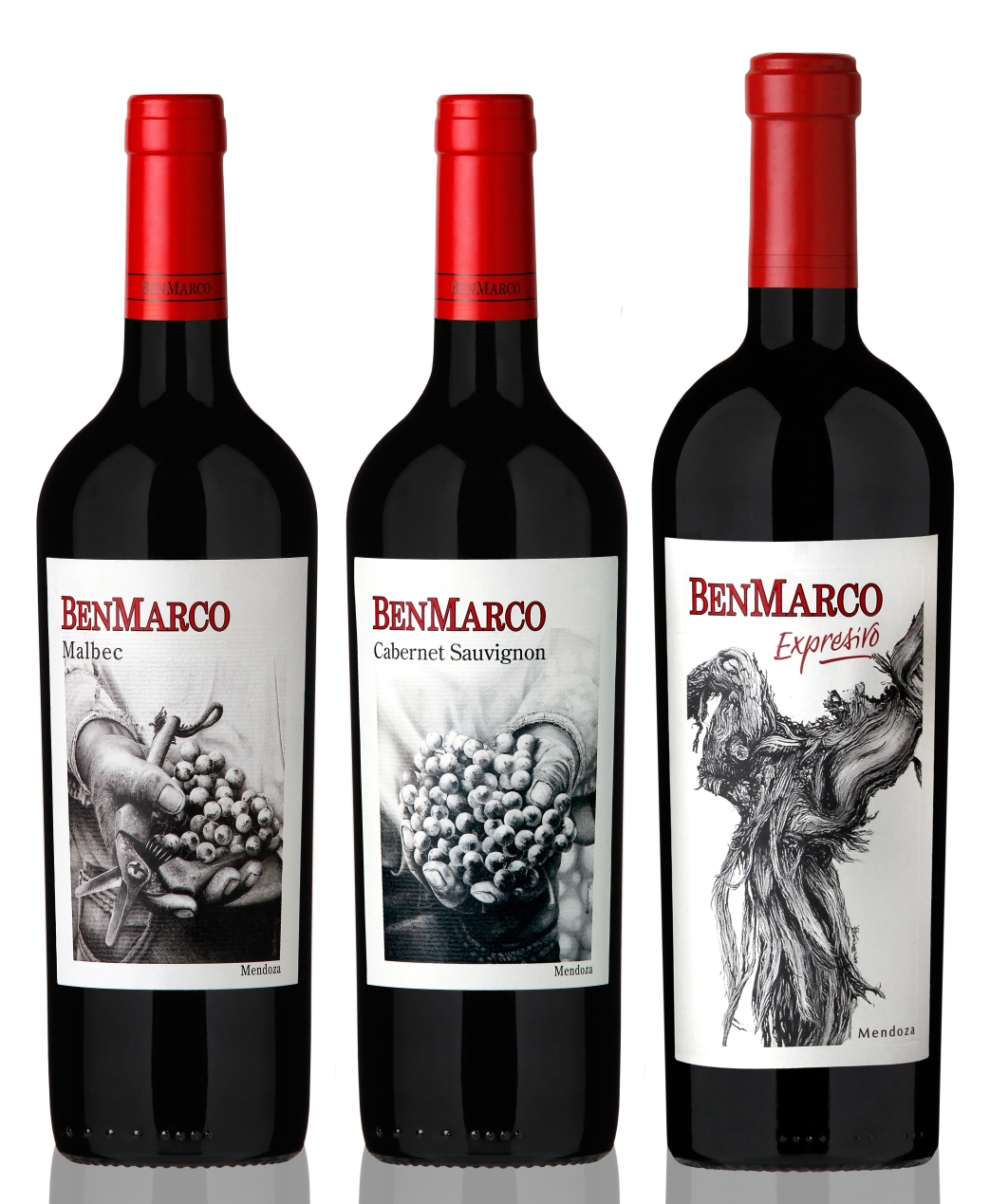
BenMarco Expresivo 2016 ($35)—General
Manager Edgardo “Edy” Del Popolo is in charge
of Balbo’s BenMarco vineyards, where the
terroir is allowed to speak with as little
intervention by the winemaker as possible.
Prices are amazingly reasonable. This blend of
75% Malbec and 25% Cabernet Franc, with just
13.5% alcohol, is a red wine of brightness and
earthiness without being overpowered or out of
balance. Terrific with steak.
BenMarco Malbec
Valle de Uco 2016 ($25)—Malbec is
currently the darling of Argentine
viniculture, and this bottle contains 100% of
it, at 13.5% alcohol. Unlike its often inky
French cousin Cahors, made from the same
grape, this is a softer, silkier version that
is ideal with pork, roast chicken or veal
Milanese.
BenMarco Cabernet Sauvignon 2016 ($20)—On the other hand, if you like more tannin, this 100% Cab, at just 13.8% alcohol, shows how vivid the grape can be if not allowed to ferment into a one-dimensional blockbuster. Char-grilled anything, spicy sausages, Italian pasta sauces will all be enhanced by this excellent offering.
❖❖❖
 DEPT.
OF WRETCHED EXCESS
DEPT.
OF WRETCHED EXCESS
As of January 1st, a dinner for two at NYC's Per
Se costs
in excess of $700 before wine, tax, or
supplements. At Eleven Madison Park a wine-paired
dinner now costs $1,100.
Housing for detained immigrants at the Mexican
border costs $200 per day per person.
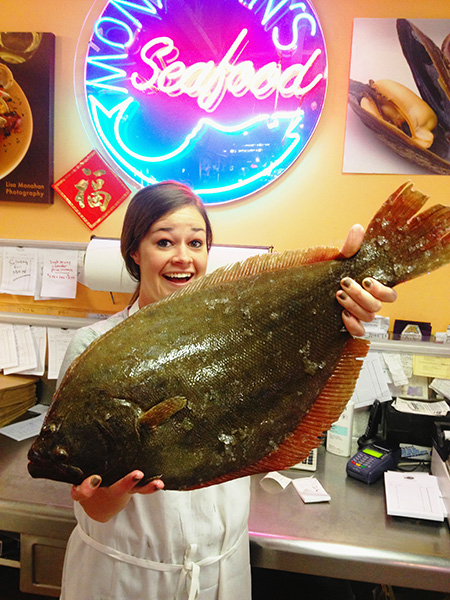
"Fluke Crudo Is a Scourge That Must Be Stopped"—Chris Crowley, NY
Magazine (12/4/18).
Wine
Column Sponsored by Banfi Vintners
SANGIOVESE
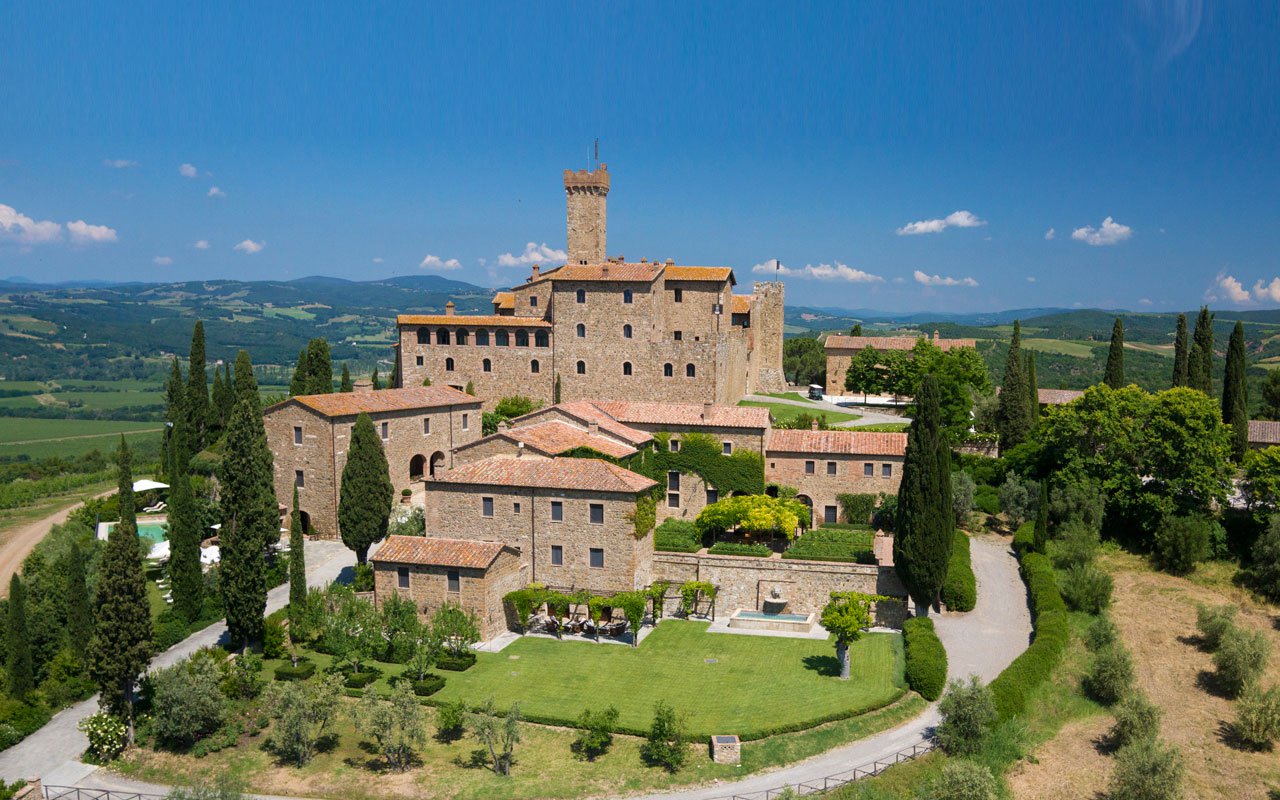 Wine is a joy year-round but
in cooler weather one
grape varietal has really taken center stage in
my daily activities – that most Italian of
grapes, Sangiovese, and its ultimate expression
– Brunello di Montalcino.
Wine is a joy year-round but
in cooler weather one
grape varietal has really taken center stage in
my daily activities – that most Italian of
grapes, Sangiovese, and its ultimate expression
– Brunello di Montalcino.
From mid-September through mid-October,
the Sangiovese grown for our various styles of red
wines are be harvested, culminating with the top
selection for Brunello di Montalcino.
Second, cooler weather here means
it is time to start enjoying more red wines and
especially Sangiovese based wines. That
includes Banfi’s cru of Brunello, Poggio alle Mura,
literally the cream of the crop of our Sangiovese
vineyards. Alongside our Poggio alle Mura Brunello di
Montalcino, this year we introduced two more wines
from the cru Poggio alle Mura – a Rosso di Montalcino
and a Riserva of Brunello. Rosso is sort of like the
younger brother of Brunello, also made from 100%
Sangiovese grapes but usually a selection from younger
vines and the wine is aged only two years compared to
the four required for Brunello. The
Riserva, on the other hand, is an even more selective
harvest of Sangiovese, and ages for an additional year
before release.
What is so special about this cru
Poggio alle Mura?
Well, it is the result our over 30 years of
ongoing research at my family’s vineyard estate,
Castello Banfi.
When we first began planting our vines there in
the late 1970s studies from the University of Bordeaux
indicated which strains of many varietals we should
plant, based on the soil type and microclimate of each
vineyard. But
when it came to the region’s native Sangiovese, there
was only local lore, no scientific research. So we took
it upon ourselves to figure out this vine, and set off
on three decades of incredibly detailed research.
We started
with 600 apparent variations on Sangiovese, because it
is so susceptible to variations in weather and soil,
and narrowed that down to 160 truly genetically
different clones.
We planted a vineyard with two rows of each
type, made wine from each of them, and charted the
differences – remember, you only get one chance a year
to make wine, so this took time.
It took about ten years to get some
concrete results, though we continue to experiment
today and always will – you never stop learning in
science and nature!
Once we determined which were the best,
complementary clones that could be planted together to
make the best Brunello, we chose to plant them in what
we determined to be the optimal vineyard sites. Coincidentally,
the best soils and climate conditions are in the
slopes surrounding the medieval fortress today known
as Castello Banfi, known since Etruscan times as
Poggio alle Mura – the walled hilltop. Hence the
name of our most special “cru” of Brunello,
representing a synthesis between tradition and
innovation.
Though the focus of this study was
our Brunello, all of our Sangiovese-based wines,
including the super Tuscans SummuS, Cum Laude, and
Centine, benefitted from this work. And that’s
the third reason for celebrating Sangiovese this
month, for the range of wonderful reds that usher us
into autumn! One
wine in particular was inspired by our research – the
BelnerO, a Sangiovese dominant blend with what I like
to call a kiss of Cabernet and a whisper of Merlot. We grow the
grapes a little differently for BelnerO than for
Brunello, make the wine with less oak aging and
released it earlier from the winery, providing a
counterpoint to Brunello and a lovely terroir-driven
wine in its own right.
If you
know Italians, you know that by nature we are
multi-faceted, varying in mood, and always passionate. As a
nation, we span from the hot sunny beaches of Sicily
near the African coast to the rugged mountains and
Alpine ski slopes of Trentino-Alto Adige in the north. Sangiovese
is grown in almost all of Italy’s regions and reflects
the unique nature of each; it is most famous
(rightfully so) in Tuscany, yet even there it reflects
the nuances of each hilltop, valley and subzone. It has
something a little different to say in Brunello than
Chianti, Morellino than Vino Nobile di Montepulciano,
Rosso di Montalcino than Super Tuscan blends.
Here is a smattering of
Sangiovese-based wines that you may wish to get to
know better, reflecting a spectrum that appeals to
every occasion, every taste, and every budget. We can
assure you that the conversation will never become
boring. 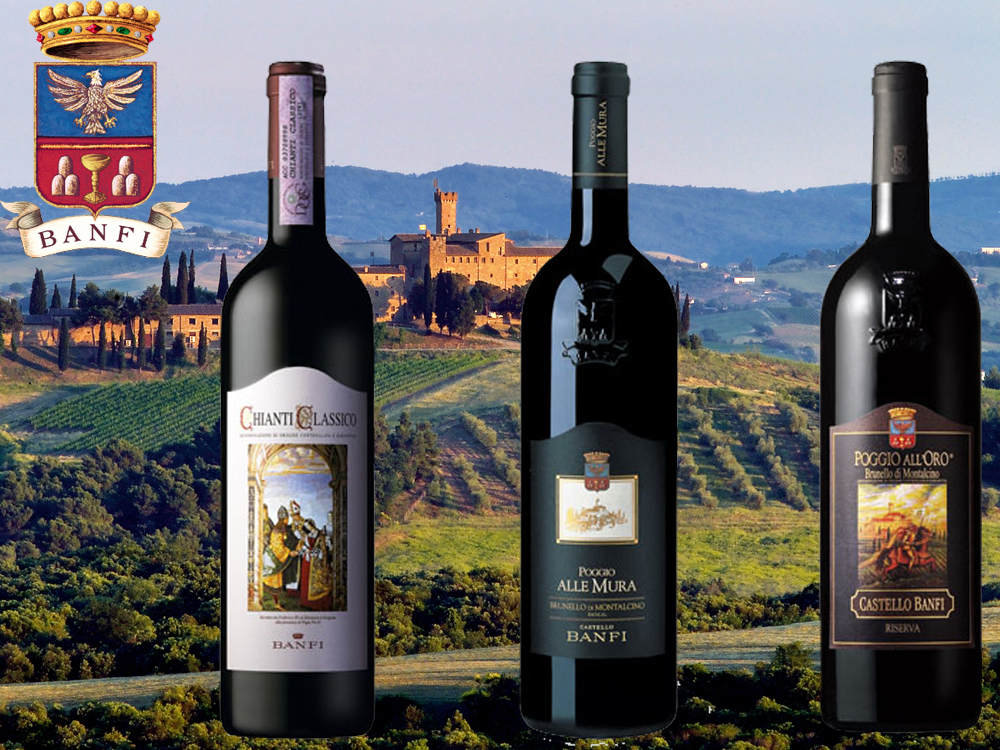
Recommendations for Celebrating
Sangiovese
BelnerO Proprietor’s Reserve Sangiovese
– A refined
cuvée of noble red grapes perfected by our pioneering
clonal research. This dark beauty, BelnerO, is
produced at our innovative winery, chosen 11
consecutive years as Italy’s Premier Vineyard Estate.
Fermented in our patented temperature controlled
French oak and aged approximately 2 additional years.
Unfiltered, and Nitrogen bottled to minimize sulfites.
Castello Banfi Brunello di Montalcino –
Rich, round, velvety and intensely
aromatic, with flavor hints of licorice, cherry, and
spices. Brunello di Montalcino possesses an intense
ruby-red color, and a depth, complexity and opulence
that is softened by an elegant, lingering aftertaste.
Unfiltered after 1998 vintage.
Castello Banfi Rosso di Montalcino – Brunello's "younger brother," produced
from select Sangiovese grapes and aged in barrique for
10 to 12 months. Deep ruby-red, elegant, vibrant,
well-balanced and stylish with a dry velvety
finish.
Poggio all’Oro Brunello di Montalcino
Riserva – A single vineyard selection of our most
historically outstanding Sangiovese, aged five years
before release, the additional year more than that
required of Brunello including 6 months in barrel and
6 months more in bottle to grant its “Riserva”
designation. Incredible
elegance and harmony. Intense with lots of fruit and
subtle wood influence. Round, complete, well balanced
with hints of chocolate and berries. Unfiltered after
1998.
Poggio alle Mura – The first tangible result of years of
intensive clonal research on Montalcino’s native
Sangiovese grape.
Estate bottled from the splendidly sun drenched
vineyards surrounding the medieval Castello from which
it takes its name.
The Brunello
di Montalcino is seductive, silky and smoky. Deep ruby
in color with an expressive bouquet of violets, fruits
and berries as well as cigar box, cedar and exotic
spices. The Rosso
di Montalcino is also intense ruby red. The bouquet
is fresh and fruity with typical varietal notes of
cherry and blackberry, enriched by more complex hints
of licorice, tobacco and hazelnut. It is full
bodied, yet with a soft structure, and a surprisingly
long finish. The Poggio alle Mura Brunello di Montalcino
Riserva is deep ruby red with garnet
reflections and a rich, ample bouquet that hints of
prune jam, coffee, cacao and a light balsamic note. It is full
and powerful, with ripe and gentle tannins that make
it velvety and harmonious; this wine is supported by a
pleasing minerality that to me speaks soundly of that
special hillside in southern Montalcino.
SummuS – A wine of towering elegance, SummuS is an
extraordinary blend of Sangiovese which contributes
body; Cabernet Sauvignon for fruit and structure; and
Syrah for elegance, character and a fruity bouquet. An elegant,
complex and harmonious red wine.
Cum Laude – A complex and elegant red which graduated
“With Honors,” characterized by aromas of juicy
berries and fresh spices.
Centine – A Cuvee that is more than half
Sangiovese, the balanced consisting of equal parts of
Cabernet Sauvignon and Merlot. Vinified in
a firm, round style that easily accompanies a wide
range of dishes, this is a smooth and fragrantly
satisfying wine with international character, and a
perennial favorite at my own dinner table.
Banfi Chianti Superiore – The “Superiore” designation signifies
stricter government regulations regarding production
and aging requirements, as compared to regular
Chianti. An
intense ruby red wine with fruit forward aromas and
floral notes. This
is a round wine with well-balanced acidity and fruit.
Banfi Chianti Classico – An enduring classic: alluring
bouquet of black fruit and violets; rich flavors of
cherry and leather; supple tannins and good acidity
for dining.
Banfi Chianti Classico Riserva – Produced from select grapes grown in the
"Classico" region of Chianti, this dry, fruity and
well-balanced red has a full bouquet reminiscent of
violets.
Fonte alla Selva Chianti Classico – This is our newest entry into the Chianti
arena, coming from a 99 acre estate in Castellina, the
heart of the Chianti Classico region. The wine is
a captivating mauve red that smells of cherry, plum
and blackberry with hints of spice. It is
round, full and balanced with very good
acidity.
Col di Sasso – Sangiovese and Cabernet Sauvignon. Luscious,
complex and soft with persistent notes of fruit and
great Italian style structure.
❖❖❖
Any of John Mariani's books below may be ordered from amazon.com.
 The Hound in Heaven
(21st Century Lion Books) is a novella, and
for anyone who loves dogs, Christmas, romance,
inspiration, even the supernatural, I hope you'll find
this to be a treasured favorite. The story
concerns how, after a New England teacher, his wife and
their two daughters adopt a stray puppy found in their
barn in northern Maine, their lives seem full of promise.
But when tragedy strikes, their wonderful dog Lazarus and
the spirit of Christmas are the only things that may bring
his master back from the edge of despair.
The Hound in Heaven
(21st Century Lion Books) is a novella, and
for anyone who loves dogs, Christmas, romance,
inspiration, even the supernatural, I hope you'll find
this to be a treasured favorite. The story
concerns how, after a New England teacher, his wife and
their two daughters adopt a stray puppy found in their
barn in northern Maine, their lives seem full of promise.
But when tragedy strikes, their wonderful dog Lazarus and
the spirit of Christmas are the only things that may bring
his master back from the edge of despair. WATCH THE VIDEO!
“What a huge surprise turn this story took! I was completely stunned! I truly enjoyed this book and its message.” – Actress Ali MacGraw
“He had me at Page One. The amount of heart, human insight, soul searching, and deft literary strength that John Mariani pours into this airtight novella is vertigo-inducing. Perhaps ‘wow’ would be the best comment.” – James Dalessandro, author of Bohemian Heart and 1906.
“John Mariani’s Hound in Heaven starts with a well-painted portrayal of an American family, along with the requisite dog. A surprise event flips the action of the novel and captures us for a voyage leading to a hopeful and heart-warming message. A page turning, one sitting read, it’s the perfect antidote for the winter and promotion of holiday celebration.” – Ann Pearlman, author of The Christmas Cookie Club and A Gift for my Sister.
“John Mariani’s concise, achingly beautiful novella pulls a literary rabbit out of a hat – a mash-up of the cosmic and the intimate, the tragic and the heart-warming – a Christmas tale for all ages, and all faiths. Read it to your children, read it to yourself… but read it. Early and often. Highly recommended.” – Jay Bonansinga, New York Times bestselling author of Pinkerton’s War, The Sinking of The Eastland, and The Walking Dead: The Road To Woodbury.
“Amazing things happen when you open your heart to an animal. The Hound in Heaven delivers a powerful story of healing that is forged in the spiritual relationship between a man and his best friend. The book brings a message of hope that can enrich our images of family, love, and loss.” – Dr. Barbara Royal, author of The Royal Treatment.
 |
The Encyclopedia of American Food and Drink by John F. Mariani (Bloomsbury USA, $35) Modesty forbids me to praise my own new book, but let me proudly say that it is an extensive revision of the 4th edition that appeared more than a decade ago, before locavores, molecular cuisine, modernist cuisine, the Food Network and so much more, now included. Word origins have been completely updated, as have per capita consumption and production stats. Most important, for the first time since publication in the 1980s, the book includes more than 100 biographies of Americans who have changed the way we cook, eat and drink -- from Fannie Farmer and Julia Child to Robert Mondavi and Thomas Keller. "This book is amazing! It has entries for everything from `abalone' to `zwieback,' plus more than 500 recipes for classic American dishes and drinks."--Devra First, The Boston Globe. "Much needed in any kitchen library."--Bon Appetit. |
"Eating Italian will never be the same after reading John Mariani's entertaining and savory gastronomical history of the cuisine of Italy and how it won over appetites worldwide. . . . This book is such a tasteful narrative that it will literally make you hungry for Italian food and arouse your appetite for gastronomical history."--Don Oldenburg, USA Today. "Italian
restaurants--some good, some glitzy--far
outnumber their French rivals. Many of
these establishments are zestfully described
in How Italian Food Conquered the World, an
entertaining and fact-filled chronicle by
food-and-wine correspondent John F.
Mariani."--Aram Bakshian Jr., Wall Street
Journal.
"Equal parts
history, sociology, gastronomy, and just
plain fun, How Italian Food Conquered the
World tells the captivating and delicious
story of the (let's face it) everybody's
favorite cuisine with clarity, verve and
more than one surprise."--Colman Andrews,
editorial director of The Daily
Meal.com. "A fantastic and fascinating
read, covering everything from the influence
of Venice's spice trade to the impact of
Italian immigrants in America and the
evolution of alta cucina. This book will
serve as a terrific resource to anyone
interested in the real story of Italian
food."--Mary Ann Esposito, host of PBS-TV's
Ciao
Italia. "John Mariani has written the
definitive history of how Italians won their
way into our hearts, minds, and
stomachs. It's a story of pleasure over
pomp and taste over technique."--Danny Meyer,
owner of NYC restaurants Union Square
Cafe, The Modern, and Maialino.
|
 |
 |
 |
 |
 |
 |
 |
 |
 Everett Potter's Travel Report:
Everett Potter's Travel Report: 
 Eating Las Vegas
JOHN CURTAS has been covering the Las Vegas
food and restaurant scene since 1995. He is
the co-author of EATING LAS VEGAS – The 50
Essential Restaurants (as well as
the author of the Eating Las Vegas web site: www.eatinglasvegas.
He can also be seen every Friday morning as
the “resident foodie” for Wake Up With the
Wagners on KSNV TV (NBC) Channel 3 in
Las Vegas.
Eating Las Vegas
JOHN CURTAS has been covering the Las Vegas
food and restaurant scene since 1995. He is
the co-author of EATING LAS VEGAS – The 50
Essential Restaurants (as well as
the author of the Eating Las Vegas web site: www.eatinglasvegas.
He can also be seen every Friday morning as
the “resident foodie” for Wake Up With the
Wagners on KSNV TV (NBC) Channel 3 in
Las Vegas.
MARIANI'S VIRTUAL GOURMET
NEWSLETTER is published weekly. Publisher: John Mariani. Editor: Walter Bagley. Contributing Writers: Christopher Mariani,
Robert Mariani, Misha Mariani, John A. Curtas, Gerry Dawes, Geoff Kalish,
and Brian Freedman. Contributing
Photographer: Galina Dargery. Technical
Advisor: Gerry
McLoughlin.
If you wish to subscribe to this
newsletter, please click here: http://www.johnmariani.com/subscribe/index.html
© copyright John Mariani 2019

